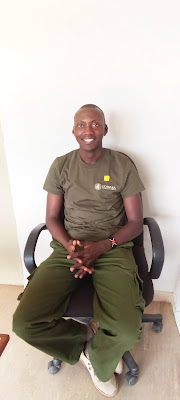A Sense of Community
Paul Naiputari, the Community Development Officer and Liason Officer, forges the important link between Loisaba and the local communities which share boundaries with the conservancy. There are two distinct, but related tribes that live close by on the other side of the Ewaso River. These are the Samburu – over the county boundary into Isiolo County, and the Maasai who live in Laikipia itself.
He started work at Loisaba in 2017 having previously been a
Research Assistant for an organisation known as LIMA – Livelihood in Mixed
Agriculture. This looked at the important and contentious issues around land
management and pastoralism, many of which go back to colonial times when the
migration of pastoralist tribes was forbidden and people were forced to inhabit
specific reserves designated for their tribe. The legacy of that time still
continues. Paul was involved in the publication of two research papers[1]
[2].
These, along with his own background as a member of the Laikipia Maasai tribe
and resident of Koija Group Ranch*, gave him a thorough grounding and
understanding of the issues and tensions around land ownership and pastoralism.
He also worked for one year at The Home Trust, children’s home which is based
in Dol-Dol.
Amongst his duties at Loisaba his remit involves
establishing and promoting a positive relationship between Loisaba Conservancy
and the neighbouring communities, assessing the communities’ needs in terms of
education, health care, grazing enterprise development and conservation
education. This involves liaising and working with community representatives,
local leaders, government ministries and development partners to provide
support to community development programmes. Needless to say, it involves a lot
of knowledge, tact and patience.
All of this is backed up by a Community Development Plan, a set budget, and a monitoring programme to look at the impact of any community development programme.
“My top priority is working towards improving the livelihood
of the neighbouring communities,” he says, “but my role has been scaling up
over time.”
“My most successful project is the conservation education program. It involves bringing school children to Loisaba’s Conservation Centre and teaching them various topics on conservation. Also, it involves setting up and visiting of wildlife clubs in schools and engaging them in conservation issues like tree planting or the protection of the giraffes– based activities around certain conservation topics.”
When the children visit the Conservation Centre there is an enviable programme throughout the day including a game drive, educational games and short talks on giraffe anatomy and the work of Twiga Walinzi (giraffes); Space for Giants (elephants); The Leopard Project and Lion Landscapes. After lunch the children also get a tour of security with Daniel and one of the rangers before being introduced to the tracker dogs. This is followed by another game drive and a visit to Loisaba Tented Camp. Out of necessity this has been curtailed by the coronavirus pandemic but normally involves fourteen different schools at primary and secondary level.
Health-wise – Paul has also been involved in setting up medical outreach centres which provide a service to remoted communities.
It quickly becomes clear that Paul’s role is deeply entwined with the work of so many others in and around Loisaba – from Ambrose who was inspired by the scheme at Loisaba to set up the Wildlife Resource Centre in his own village, Lexson and the Twiga Walinzi team, and Kaltuma the Clinical Officer from Loisaba. His work is also connected to that of the Loisaba Community Conservation Trust – of which more another time. Despite the pandemic, the programme for 2021 is ambitious and it will be Paul’s duty to deliver as much of that as he can.
Away from work he likes traditional music, and likes to watch wildlife documentaries and short comedies.
[1]
This side of subdivision: Individualization and collectivization dynamics in a
pastoralist group ranch held under collective title, German et al, 2017,
Journal of Arid Environments.
[2]
Unevenness in scale mismatches: Institutional change, pastoralist livelihoods,
and herding ecology in Laikipa, Kenya, Unks et al, 2019, Geoforum.
*Koija Group Ranch is a community owned ranch of
approximately 7,750 acres where pastoralism is the main occupation. The ranch
also does conservation work and has set aside areas for that. There
is also an ecolodge.










Comments
Post a Comment